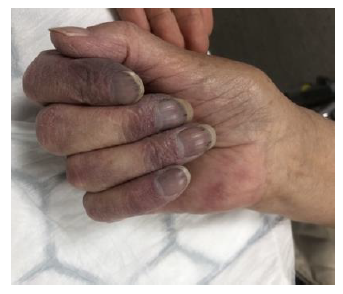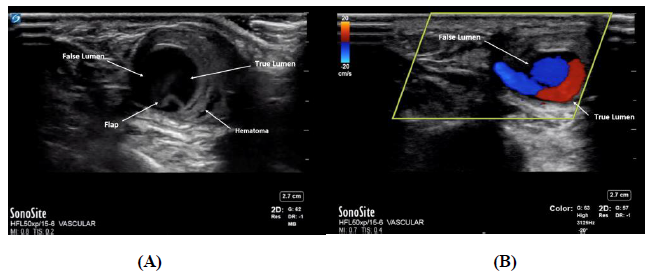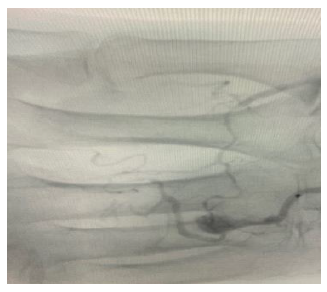Rapid Diagnosis of A Palmar Artery Pseudo-Aneurysm with Bedside Ultrasonography in Emergency Department
Article Information
Rovida S1*, Vetrugno L2, Naeem S3
1Department of Emergency Medicine, Linkoping University Hospital, Linkoping, Sweden
2Anesthesia and Intensive Care Unit, Department of Medicine, University of Udine, Udine, Italy
3Department of Emergency Medicine, Royal London Hospital, Barts Health NHS Trust, United Kingdom
*Corresponding Author: Dr. Serena Rovida, Department of Emergency Medicine, Linkoping University Hospital, Linkoping, Sweden
Received: 12 October 2020; Accepted: 09 November 2020; Published: 13 November 2020
Citation: Rovida S, Vetrugno L, Naeem S. Rapid Diagnosis of A Palmar Artery Pseudo-Aneurysm with Bedside Ultrasonography in Emergency Department. Journal of Radiology and Clinical Imaging 3 (2020): 092-095.
Share at FacebookAbstract
Aneurysms are abnormal dilations in the vessel wall due breakdown in connective tissue. Aortic aneurysms are a common presentation in the emergency department (ED) and their incidence increases with age and associated risk factors. However, palmar artery aneurysms are a rare presentation. The increasing use of point of care ultrasound (PoCUS) has facilitated early diagnosis of aneurysms in the ED and has expedited their management. In this report we describe a case of palmar artery aneurysm in a 87 year old patient which was diagnosed with PoCUS in the ED.
Keywords
Aneurysm; Ultrasound; Emergency department
Aneurysm; Ultrasound; Emergency department
Aneurysm articles Aneurysm Research articles Aneurysm review articles Aneurysm PubMed articles Aneurysm PubMed Central articles Aneurysm 2023 articles Aneurysm 2024 articles Aneurysm Scopus articles Aneurysm impact factor journals Aneurysm Scopus journals Aneurysm PubMed journals Aneurysm medical journals Aneurysm free journals Aneurysm best journals Aneurysm top journals Aneurysm free medical journals Aneurysm famous journals Aneurysm Google Scholar indexed journals Ultrasound articles Ultrasound Research articles Ultrasound review articles Ultrasound PubMed articles Ultrasound PubMed Central articles Ultrasound 2023 articles Ultrasound 2024 articles Ultrasound Scopus articles Ultrasound impact factor journals Ultrasound Scopus journals Ultrasound PubMed journals Ultrasound medical journals Ultrasound free journals Ultrasound best journals Ultrasound top journals Ultrasound free medical journals Ultrasound famous journals Ultrasound Google Scholar indexed journals Emergency department articles Emergency department Research articles Emergency department review articles Emergency department PubMed articles Emergency department PubMed Central articles Emergency department 2023 articles Emergency department 2024 articles Emergency department Scopus articles Emergency department impact factor journals Emergency department Scopus journals Emergency department PubMed journals Emergency department medical journals Emergency department free journals Emergency department best journals Emergency department top journals Emergency department free medical journals Emergency department famous journals Emergency department Google Scholar indexed journals Emergency Physician articles Emergency Physician Research articles Emergency Physician review articles Emergency Physician PubMed articles Emergency Physician PubMed Central articles Emergency Physician 2023 articles Emergency Physician 2024 articles Emergency Physician Scopus articles Emergency Physician impact factor journals Emergency Physician Scopus journals Emergency Physician PubMed journals Emergency Physician medical journals Emergency Physician free journals Emergency Physician best journals Emergency Physician top journals Emergency Physician free medical journals Emergency Physician famous journals Emergency Physician Google Scholar indexed journals point of care ultrasound articles point of care ultrasound Research articles point of care ultrasound review articles point of care ultrasound PubMed articles point of care ultrasound PubMed Central articles point of care ultrasound 2023 articles point of care ultrasound 2024 articles point of care ultrasound Scopus articles point of care ultrasound impact factor journals point of care ultrasound Scopus journals point of care ultrasound PubMed journals point of care ultrasound medical journals point of care ultrasound free journals point of care ultrasound best journals point of care ultrasound top journals point of care ultrasound free medical journals point of care ultrasound famous journals point of care ultrasound Google Scholar indexed journals palmar arch aneurysms articles palmar arch aneurysms Research articles palmar arch aneurysms review articles palmar arch aneurysms PubMed articles palmar arch aneurysms PubMed Central articles palmar arch aneurysms 2023 articles palmar arch aneurysms 2024 articles palmar arch aneurysms Scopus articles palmar arch aneurysms impact factor journals palmar arch aneurysms Scopus journals palmar arch aneurysms PubMed journals palmar arch aneurysms medical journals palmar arch aneurysms free journals palmar arch aneurysms best journals palmar arch aneurysms top journals palmar arch aneurysms free medical journals palmar arch aneurysms famous journals palmar arch aneurysms Google Scholar indexed journals dyschromia articles dyschromia Research articles dyschromia review articles dyschromia PubMed articles dyschromia PubMed Central articles dyschromia 2023 articles dyschromia 2024 articles dyschromia Scopus articles dyschromia impact factor journals dyschromia Scopus journals dyschromia PubMed journals dyschromia medical journals dyschromia free journals dyschromia best journals dyschromia top journals dyschromia free medical journals dyschromia famous journals dyschromia Google Scholar indexed journals pseudoaneurysm articles pseudoaneurysm Research articles pseudoaneurysm review articles pseudoaneurysm PubMed articles pseudoaneurysm PubMed Central articles pseudoaneurysm 2023 articles pseudoaneurysm 2024 articles pseudoaneurysm Scopus articles pseudoaneurysm impact factor journals pseudoaneurysm Scopus journals pseudoaneurysm PubMed journals pseudoaneurysm medical journals pseudoaneurysm free journals pseudoaneurysm best journals pseudoaneurysm top journals pseudoaneurysm free medical journals pseudoaneurysm famous journals pseudoaneurysm Google Scholar indexed journals vascular surgeon articles vascular surgeon Research articles vascular surgeon review articles vascular surgeon PubMed articles vascular surgeon PubMed Central articles vascular surgeon 2023 articles vascular surgeon 2024 articles vascular surgeon Scopus articles vascular surgeon impact factor journals vascular surgeon Scopus journals vascular surgeon PubMed journals vascular surgeon medical journals vascular surgeon free journals vascular surgeon best journals vascular surgeon top journals vascular surgeon free medical journals vascular surgeon famous journals vascular surgeon Google Scholar indexed journals arteriography articles arteriography Research articles arteriography review articles arteriography PubMed articles arteriography PubMed Central articles arteriography 2023 articles arteriography 2024 articles arteriography Scopus articles arteriography impact factor journals arteriography Scopus journals arteriography PubMed journals arteriography medical journals arteriography free journals arteriography best journals arteriography top journals arteriography free medical journals arteriography famous journals arteriography Google Scholar indexed journals
Article Details
1. Case Report
Peripheral artery aneurysms remain a rare presentation. Trauma to the vessel causes damage to the tunica media, resulting in a gradual dilatation of the vessel wall, hematoma formation and development of pseudoaneurysm [1, 2]. The majority of true aneurysms are due to repetitive trauma from occupational injuries or advanced atherosclerotic vessel disease, whereas the false (pseudo) aneurysms are mostly related to penetrating trauma with direct damage to the vessel wall [3-5]. Few cases of palmar arch aneurysms (PAA) have been reported in literature as shown in a recent systematic review and most of them were secondary to trauma [6]. Aneurysms can arise from any of the palmar arteries, however the ulnar artery and superficial arch are particularly prone to develop trauma due to their location and lack of palmar fascia in this area [3, 4]. The optimal management of these aneurisms is debated as several surgical or conservative approaches have been described [7].
We report a case of an 87-year-old right hand dominant lady who presented to the Emergency Medicine Department with one day history of progressive numbness and dyschromia of her right digits. No previous trauma, no occupational predisposition and no recent hand surgery were reported. The patient’s cardio pulmonary status was unremarkable. Physical examination of the right hand demonstrated marmorized phalanges of digits 2 to 5 and reduced sensitivity without any motor compromise (Figure 1). On the palmar side there was a round pulsatile compressible mass just distal to the hook of the hamate. Allen's test was negative bilaterally. A beside point of care ultrasound (PoCUS) bedside was performed by an Emergency Physician (EP) demonstrating the presence of a 24 x 17 mm pseudo-aneurysm of the palmar arch artery with mixed echogenicity and intramural hematoma. A visible floating flap was also noted (Figure 2a). The vascular surgeon was consulted, and the patient wasadmitted for further investigation and management. Angiography confirmed the presence of the superficial PAA. A coil embolization of both sides of the palmar arch artery was carried out with good outcome (Figure 3).

Figure 1: Marmorized digits of the right hand from 2nd to 5th with cyanotic distal phalanges.

Figure 2: (A) B-mode transversal axis demonstrating the aneurysmal true and false lumen with intramural hematoma and flap. (B) Doppler Signal in transversal view showing the spontaneous echo contrast indicating turbulent blood flow within the pseudoaneurysm sac so called ‘Ying- Yang’ or ‘Pepsi’ sign.

Figure 3: Arteriogram demonstrating abnormal flow in the superficial palmar arch artery.
In conclusion, PoCUS is a rapid imaging approach that can aid to formulate an accurate and real time diagnosis and it can be easily and safely performed by EPs. It can speed up the decision-making process when time really matters and an acute intervention such as early vascular reperfusion is needed. Nonetheless, its real time results can facilitate ruling out other major disorders that can present with similar clinical features. Ultrasound for PAA aneurysm is a relatively simple examination and it is often enough to confirm the diagnostic suspicion. However, the use of arteriography yields information regarding the collateral circulation and aids in preoperative planning.
Ethics approval
Not applicable.
Consent for Publication
Verbal consent was taken from the patient for the publication of this case.
Competing Interests
The authors declare that they have no competing interests.
Funding
No grants or fee was paid.
Authors' Contributions
SR, VL and SN interpreted the current literature and were involved in writing up the clinical letter. All authors read and approved the final manuscript.
References
- De Santis F, et al. Forearm and hand arteries’ aneurysms – a case report of bilateral true ulnar artery aneurysm in the hypothenar eminence and systematic review of the literature. Vascular 21 (2013): 169-176.
- Bouvet C, Bouddabous S, Beaulieu J. Aneurysms of the hand. Imaging and surgical technique. Hand Surgery and Rehabilitation 37 (2018).
- Kleinert HE, Burget GC, Morgan JA, et al. Aneurysms of the Hand. Arch Surg 106 (1973): 554-557.
- Shutze RA, Leichty J, Shutze WP. Palmar artery aneurysm. Proc (Bayl Univ Med Cent) 30 (2017): 50-51.
- L.AulicinoM.C., U.S.N.(Lt. Comdr.) P.M.J.HuttonM.C., U.S.N.R.(Lt. Comdr.) T.E.Du PuyM.C., U.S.N.(Capt.). True palmar aneurysms—A case report and literature review. The Journal of Hand Surgery 7 (1982): 613-616.
- Sheikh Z, Selvakumar S, Goon P. True aneurysm of the digital artery: a case report and systematic literature review. J Surg Case Rep (2020): rjz400.
- Igari K, Kudo T, Toyofuku T, et al. Surgical treatment of aneurysms in the upper limbs. Ann Vasc Dis 6 (2013): 637-641.
